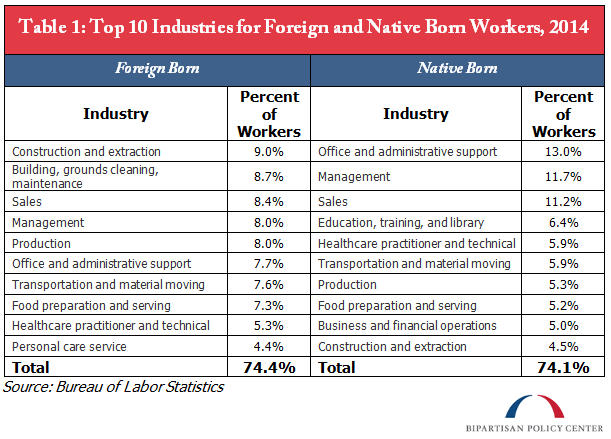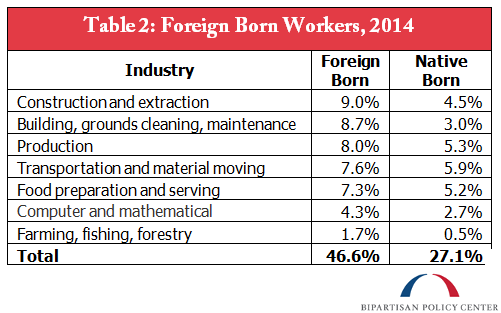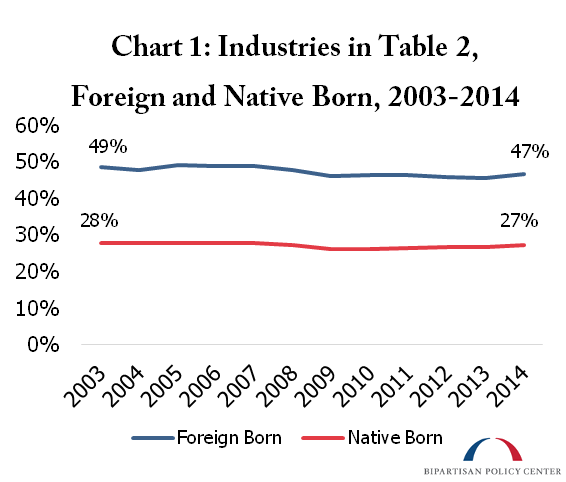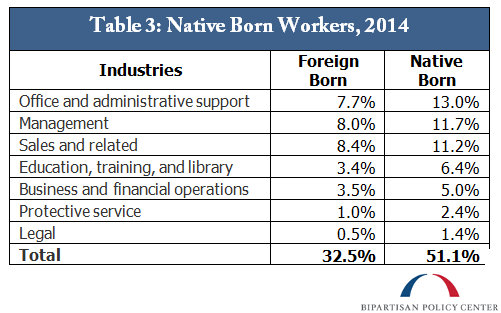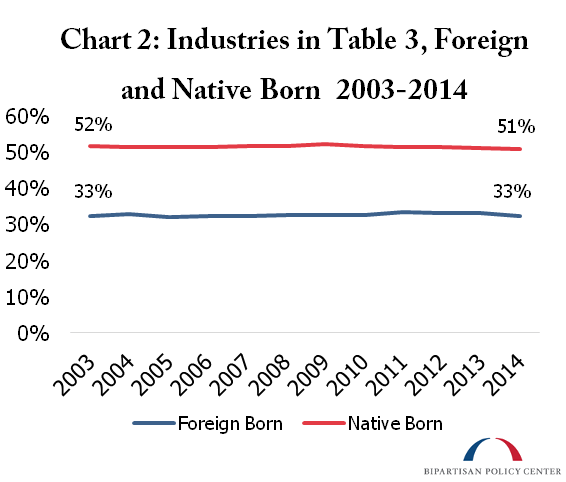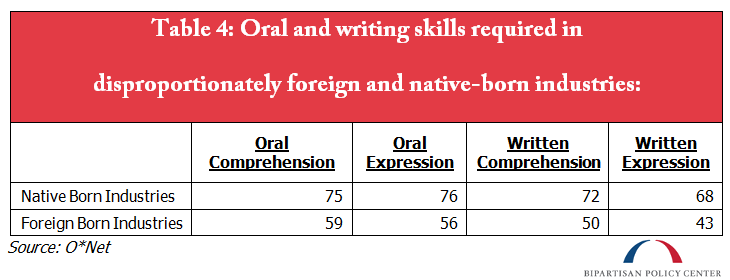Immigration and the Labor Force, Part II
Immigration helps to create and support jobs by spurring innovation, filling labor shortages and complementing the native-born workforce.
Immigration continues to be a top election issue, with most recent attention focused on the question of whether or not immigrants displace native-born Americans out of jobs.
A large body of research indicates that immigration can actually strengthen labor markets. Economist Amelie Constant of The George Washington University, in a literature review on the effects of immigration on employment, found that immigration can “stimulate job creation through increased production, self-employment, entrepreneurship, and innovation.”
According to the U.S. Small Business Administration, immigrants are more likely to be business owners, and immigrant-owned firms are more likely to hire employees. Lesser-skilled immigration can be a complementary force for higher-skill native-born workers, allowing them to specialize and upskill. And high-skilled immigration can be a boon to innovation, which can increase native-born employment and wages.
Immigrants can also work to fill labor shortages. As we wrote in our previous blog in this series, native-born workers are more likely than immigrants to exit the labor market in favor of retirement, school enrollment, or to collect disability insurance. Furthermore, according to a study in American Behavioral Scientist, the past few decades have seen declining birthrates and increased degree attainment among the native-born population. This has led to a shortage of lesser-skilled labor, which immigration has helped to fill.
Ultimately, there is overwhelming evidence that immigration plugs labor shortages, spurs job creation, and does not displace native-born jobs.
Employment Characteristics of Native and Foreign-Born
It should first be noted that a high percentage of native and foreign-born individuals do in fact work the same types of jobs. Around 75 percent of U.S. employment is driven by 10 industries, eight of which employ a high percentage of both native and foreign-born workers. According to the Bureau of Labor Statistics, “construction and extraction” is the most popular industry for immigrant workers, employing 9 percent, followed by “building, grounds cleaning and maintenance,” at 8.7 percent. For native-born workers, “office and administrative support” is the most popular industry, employing 13 percent of workers, followed by “management.” The third-most popular industry for both demographics is “sales,” which employs 8.4 percent of foreign-born and 11.2 percent of native-born workers.
However, despite broad similarities, there are several key industries that employ a disproportionate percentage of either native or foreign-born workers. Table 2, pictured below, displays seven industries that collectively employ around half of foreign-born workers?but just over a quarter of native-born workers. And table 3 displays seven industries that employ over half of native-born workers, but just over 30 percent of foreign-born workers. In general, foreign-born workers are twice as likely to work in construction and extraction, while native-born workers are about three times as likely to be employed in a legal profession. Similarly, native-born workers tend to disproportionately enter sales, management, and education, while foreign born workers are more apt to pursue computer science, the food service industry, or farming.
Industries that disproportionately employ foreign and native-born workers, 2014:
These trends have remained relatively constant over the past decade, as evidenced by charts 1 and 2, displayed above. Chart 1 plots native and foreign-born employment in disproportionately foreign-born industries. Between 2003 and 2014, foreign-born employment in these occupations declined modestly, from 49 to 47 percent, while native-born employment decreased by just one percentage point, from 28 to 27 percent. Similarly, chart 2 displays employment in disproportionately native-born industries, finding a similar pattern. Between 2003 and 2014, native-born employment in these occupations decreased by just one percentage point?from 52 to 51 percent?while foreign-born employment remained flat, at 33 percent. Ultimately, the fact that these trends have remained largely unchanged over the past ten years supports the notion that most immigrants do not compete for native-born jobs. Rather, the data suggest that a high percentage of native-born and foreign-born individuals simply work in different occupations, which means that immigration can plug labor shortages, with foreign-born workers filling positions that would otherwise likely remain vacant or disappear.
Language Requirements
In general, the disproportionately foreign-born industries require a lower level of English language proficiency than their native-born counterparts. This is unsurprising, given the fact that a majority of immigrants do not speak English as their primary language.
The Occupational Information Network (O*Net) is a database that looks at the skills demanded by hundreds of occupations, and rates them on a scale of importance from zero to 100. A zero means that the given skill is not important for that occupation, and a 100 means that it is vital. Table 4 uses O*Net to look at the average importance of written and spoken language skills in the disproportionately foreign and native-born industries, namely “oral and written comprehension” (the ability to understand spoken and written language), and “oral and written expression” (the ability to communicate through spoken language and writing). As indicated by the table, these four skills are far more important for the predominantly native-born industries, which score an average of around 20 points higher than the foreign-born industries. This is particularly true for “written expression,” which scores a 68 for native-born, versus a 43 for foreign-born.
Salary and Education Requirements
There are also wide discrepancies in wage and educational requirements between the predominantly foreign and native-born industries. In general, the disproportionately foreign-born industries are comprised of lower-wage and lower-skill occupations. As noted previously, this can in part be attributed to higher educational attainment among native-born workers, which has decreased their demand for less-skilled jobs. According to the Bureau of Labor Statistics, 68 percent of the native-born workforce age 25 and older has completed at least some college, compared to just 52 percent of the foreign-born labor force. Similar, 38 percent of said native-born workers hold at least a bachelor’s degree, compared to 34 percent of foreign-born workers.
According to table 5, the disproportionately foreign-born industries pay an average annual salary of around $35,000, and just 19 percent of the 81 occupations within these industries require at least a Bachelor’s degree. When excluding computer and mathematical occupations?the lone high-skill industry in table 5?none require a bachelor’s degree, and the average annual salary drops to around $25,000.
On the other hand, the predominantly native-born industries pay an average of around $53,000 per year, and 58 percent of the 91 occupations within these industries require at least a bachelor’s degree. According to table 6, four of the seven industries pay over $40,000 per year, and only sales occupations pay less than an average of $30,000 per year.
In short, the research and data clearly demonstrate that immigration is a net positive for jobs and the economy, as it spurs innovation and fills shortages in predominantly lower-wage, lesser-skill occupations. With this issue continuing to dominate the 2016 election cycle, it is important to separate facts from rhetoric. Immigration does not displace native-born jobs?it supports them.
Zuzana Jerabek contributed to this post.
Share
Read Next
Support Research Like This
With your support, BPC can continue to fund important research like this by combining the best ideas from both parties to promote health, security, and opportunity for all Americans.
Give NowRelated Articles
Join Our Mailing List
BPC drives principled and politically viable policy solutions through the power of rigorous analysis, painstaking negotiation, and aggressive advocacy.
